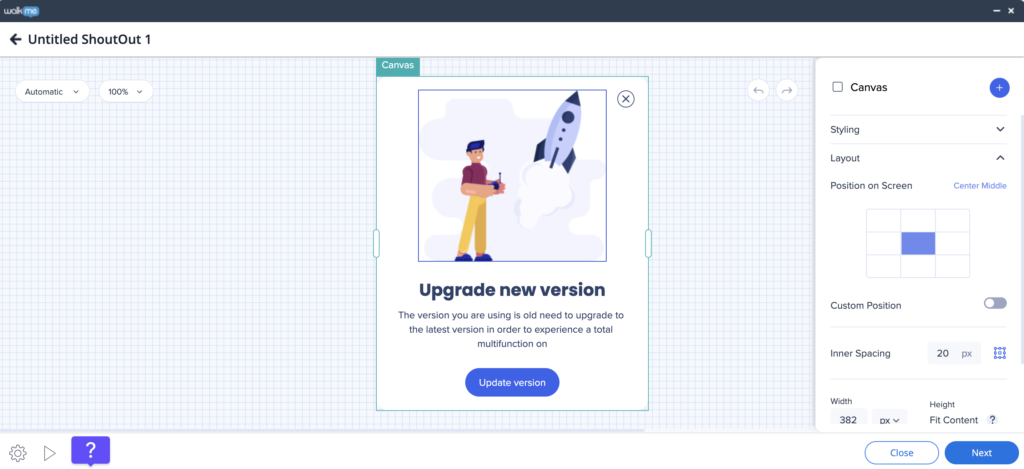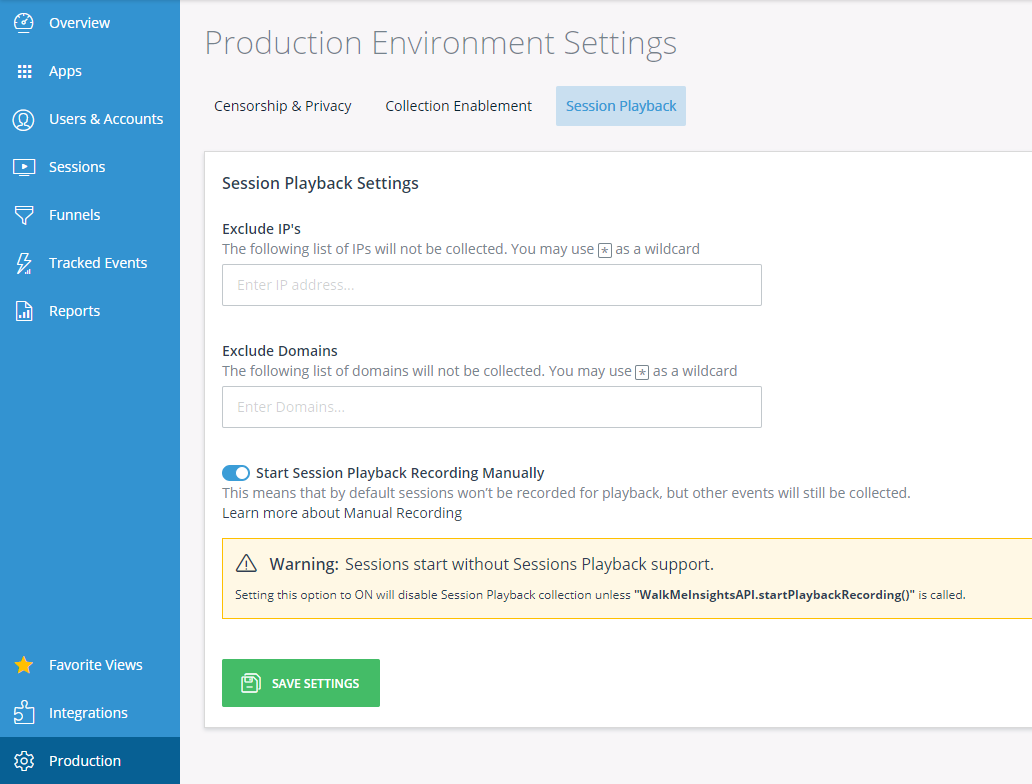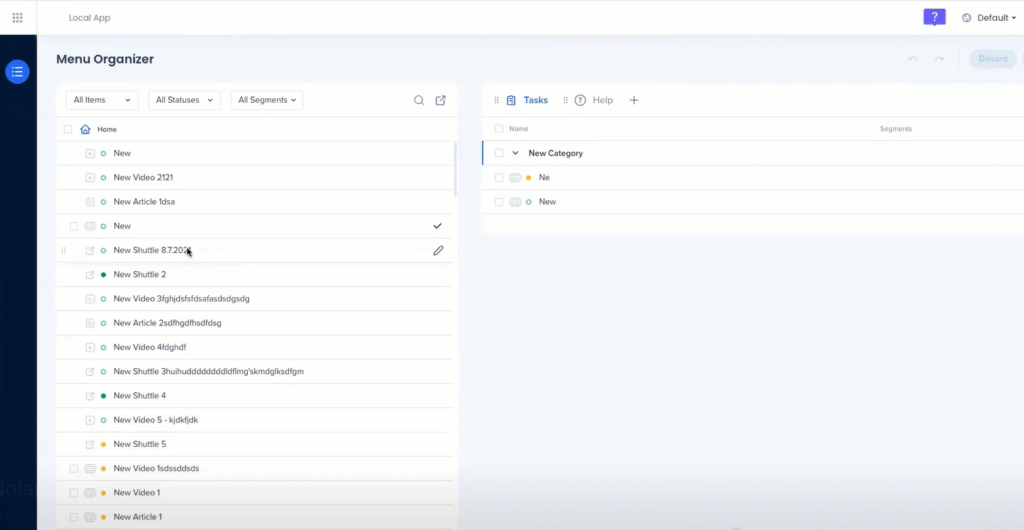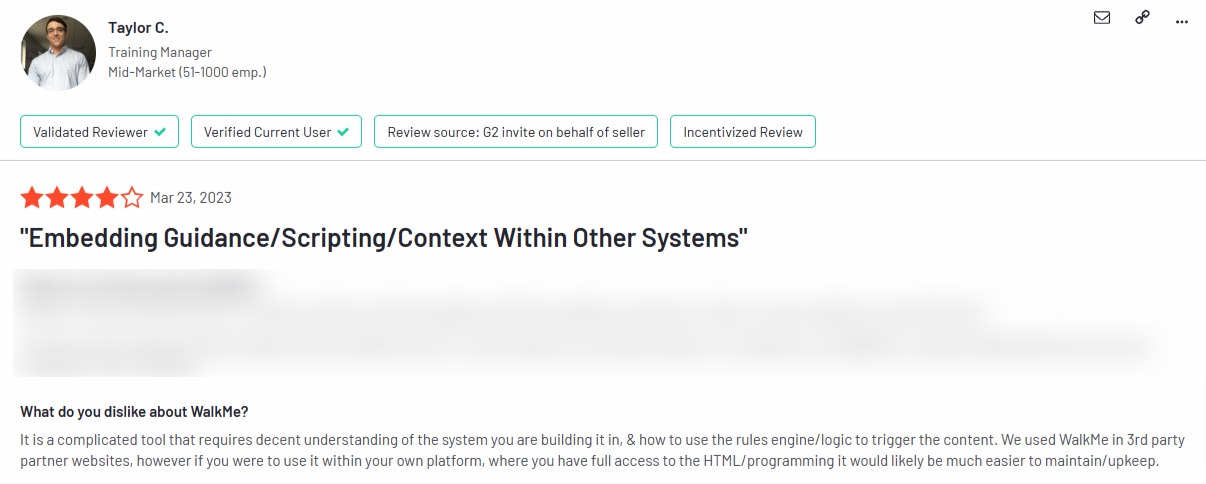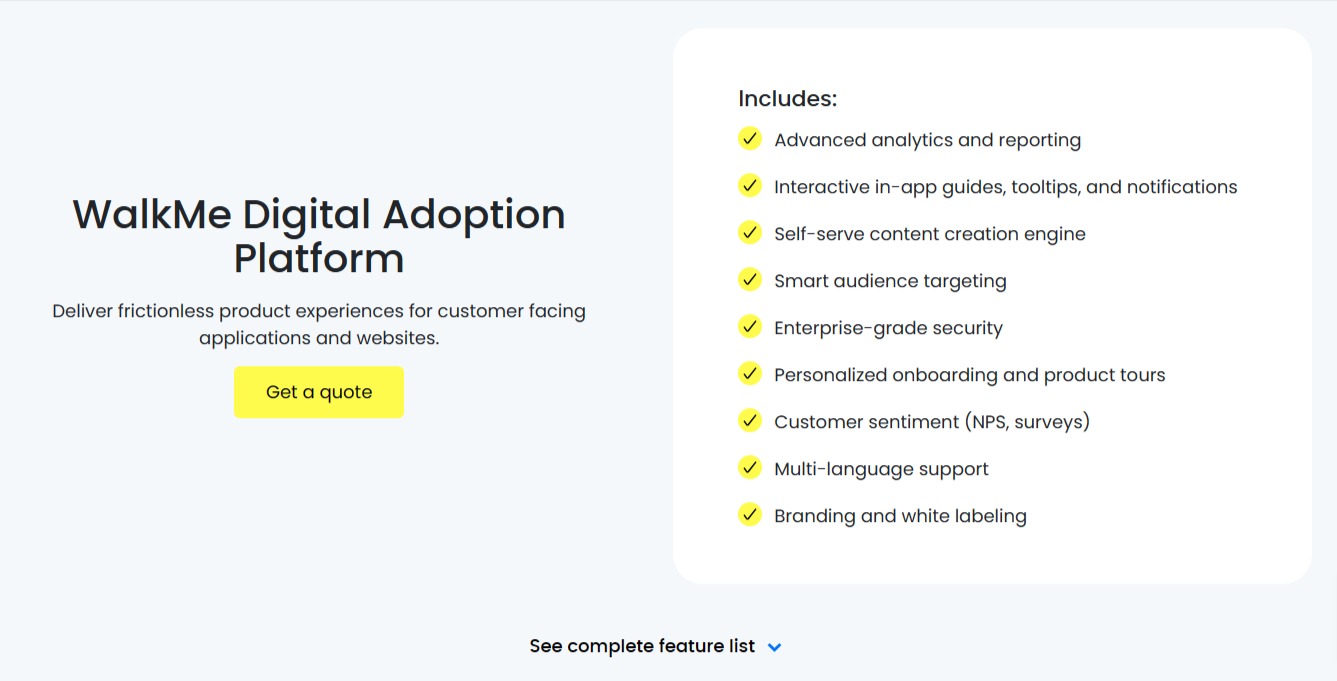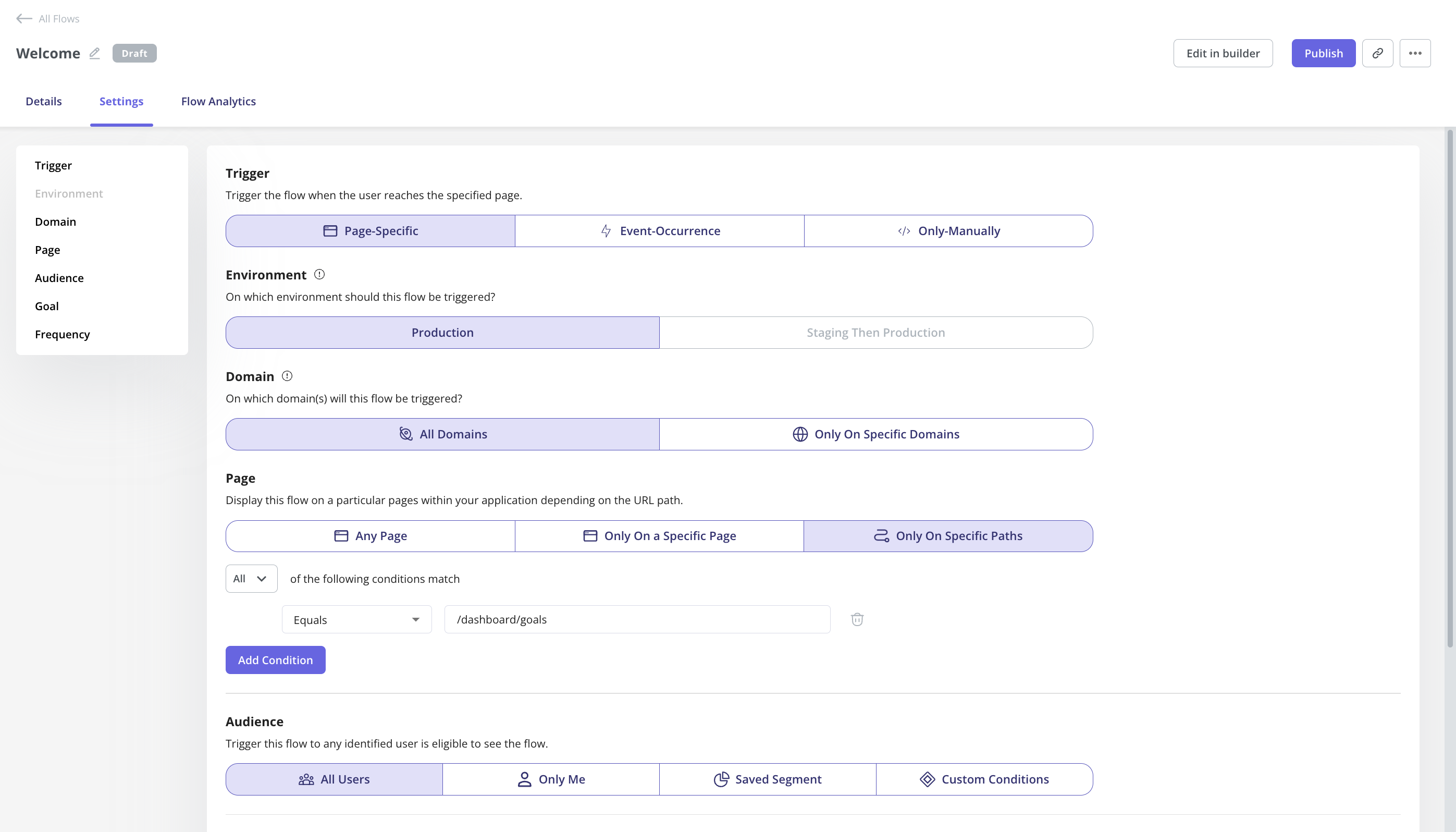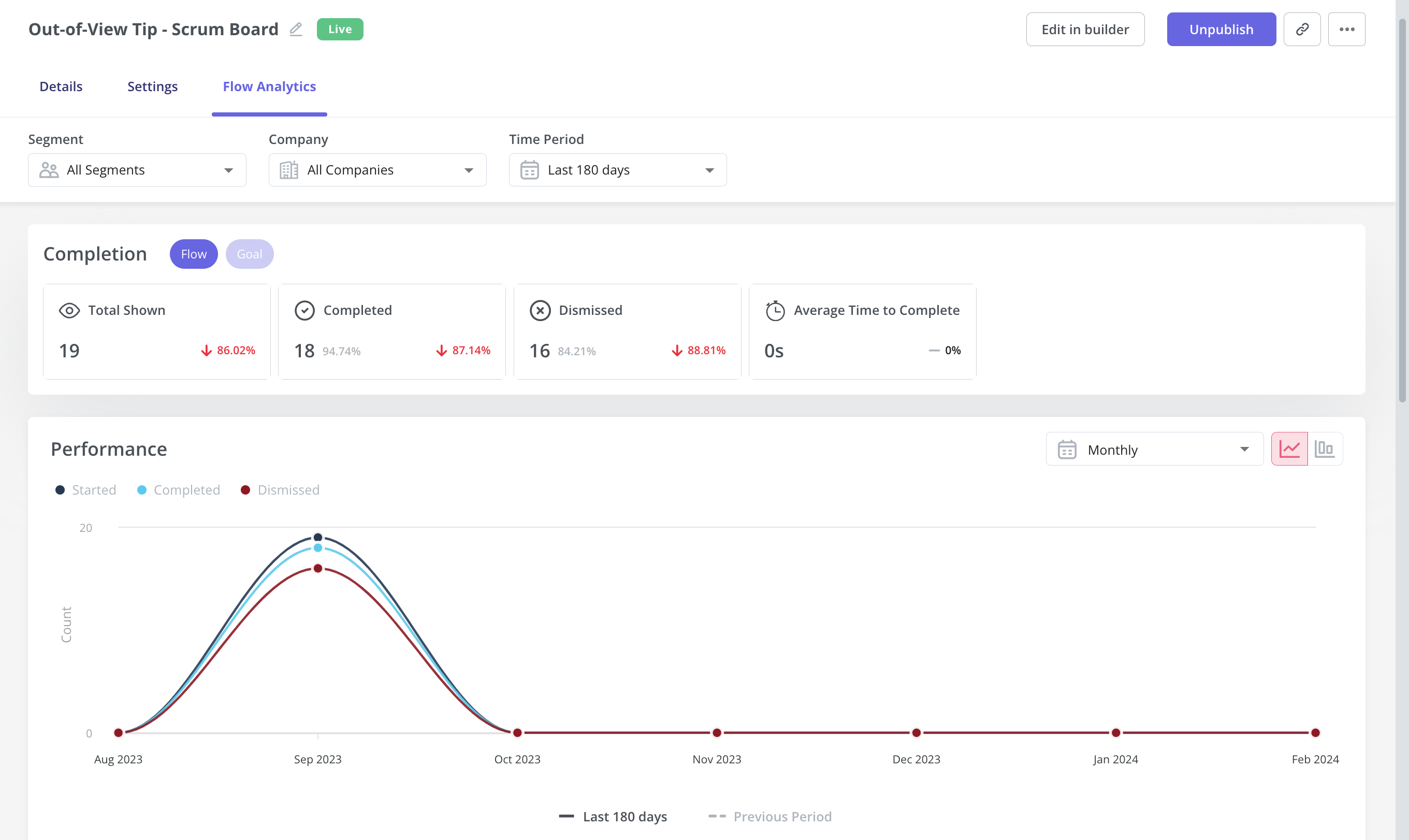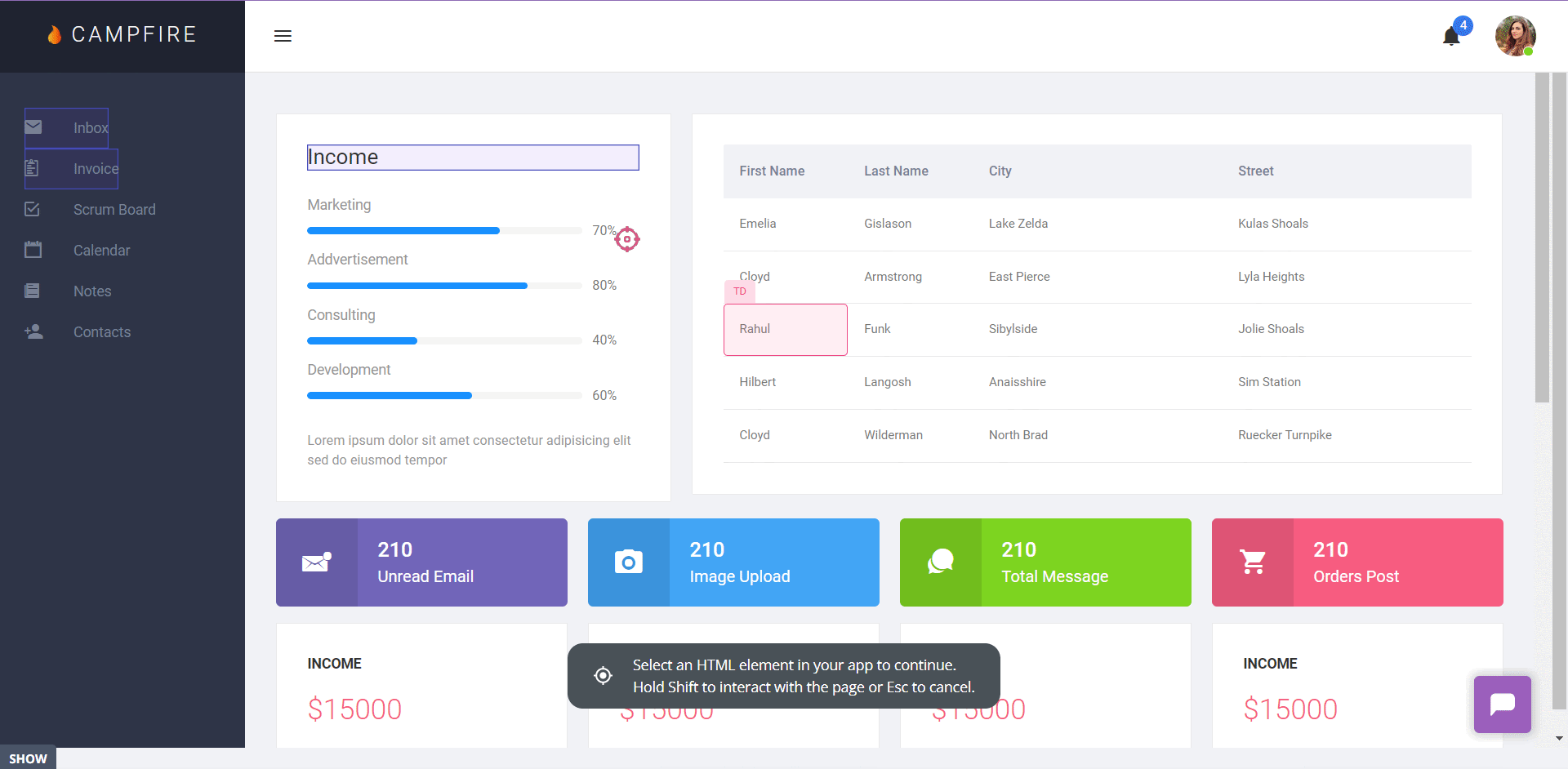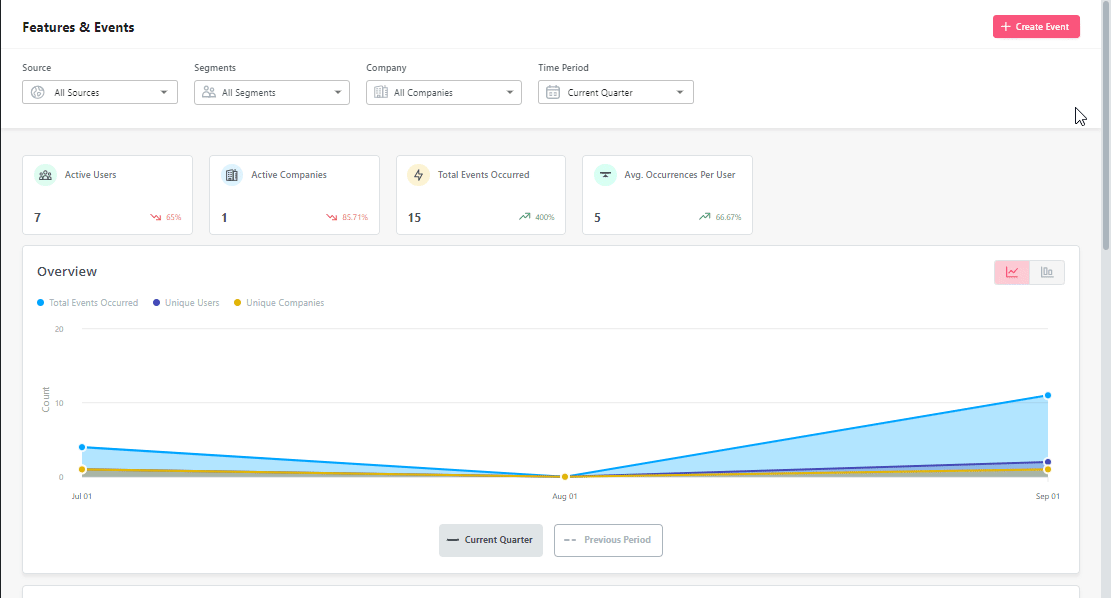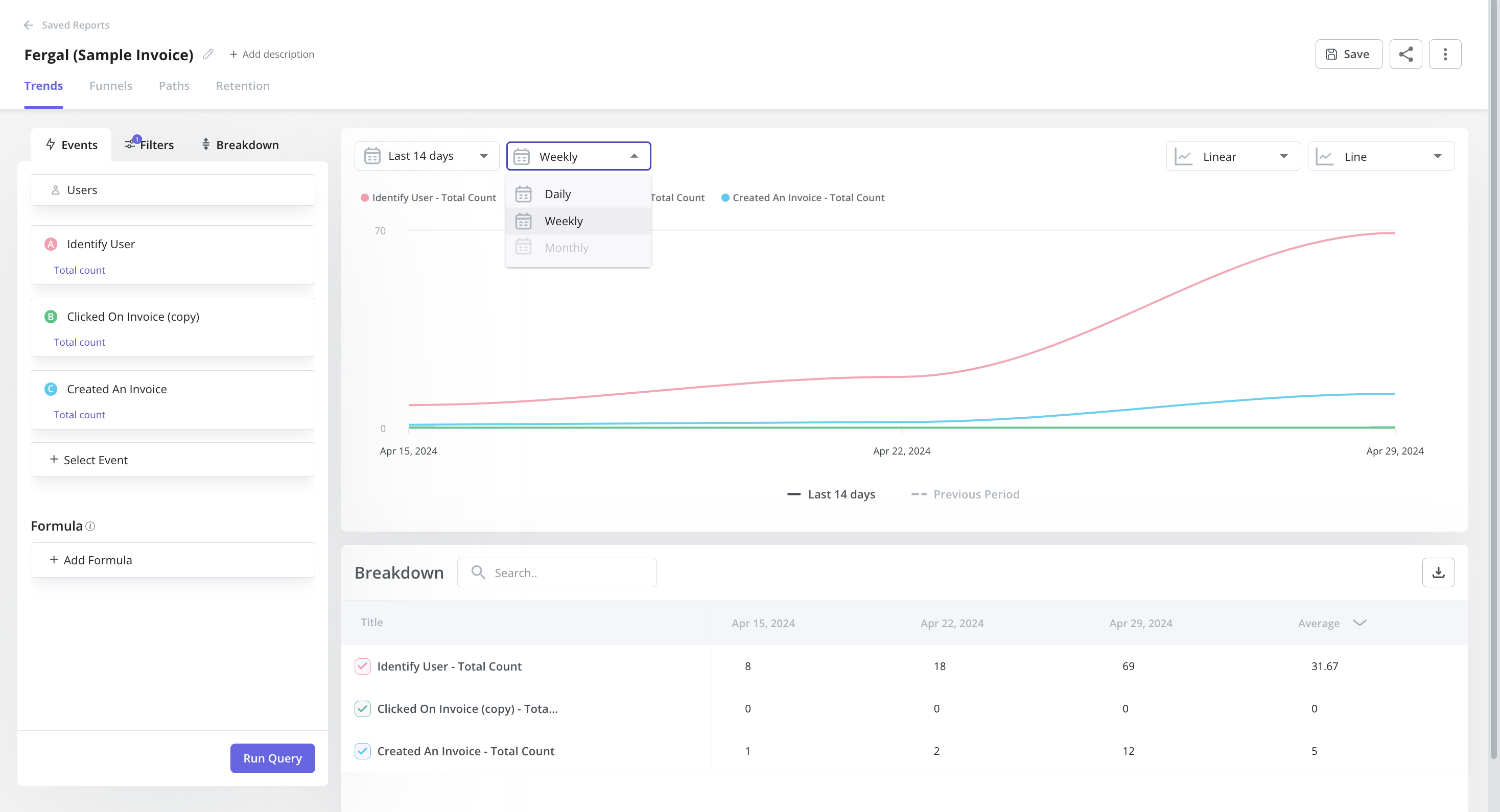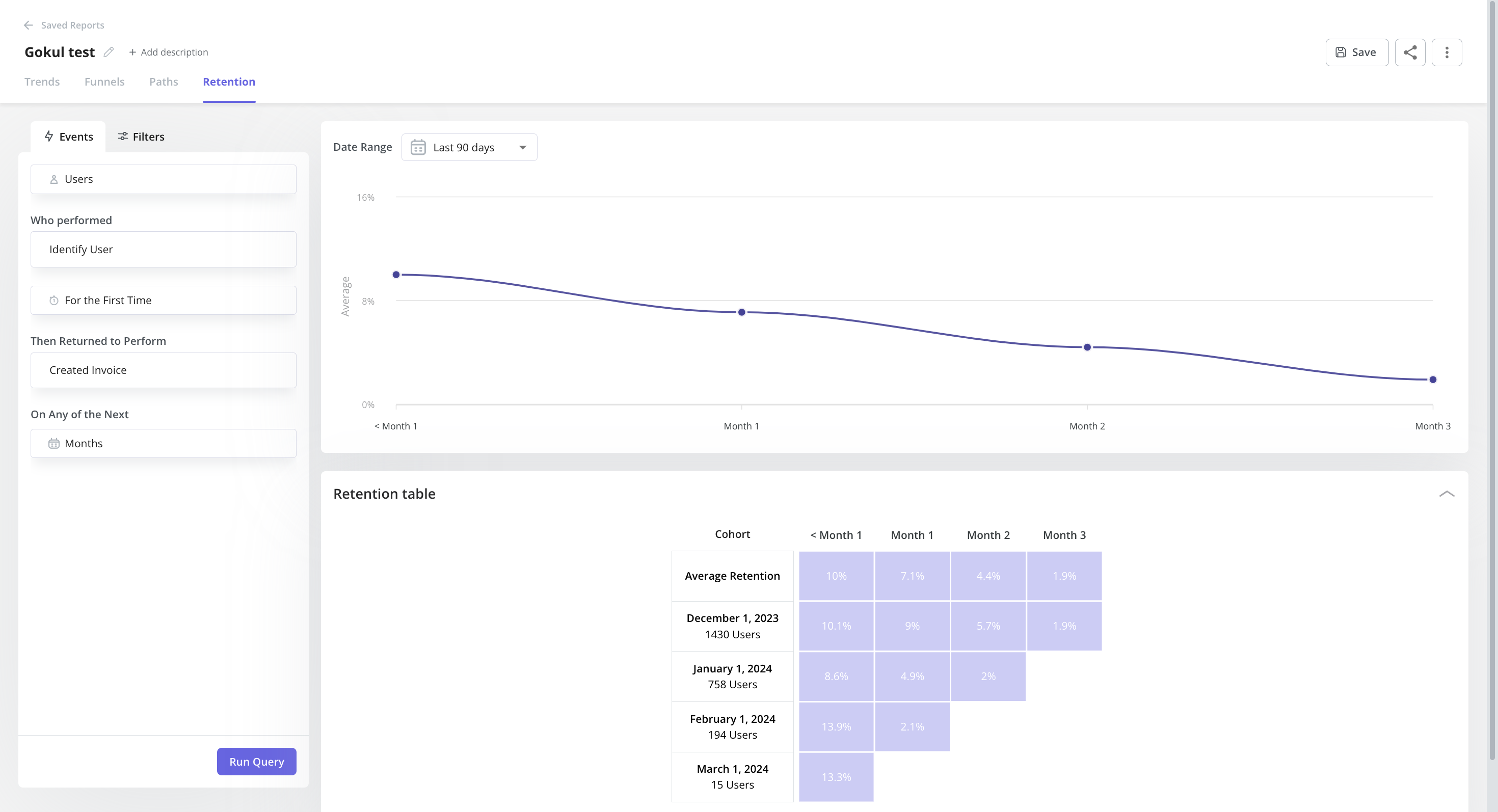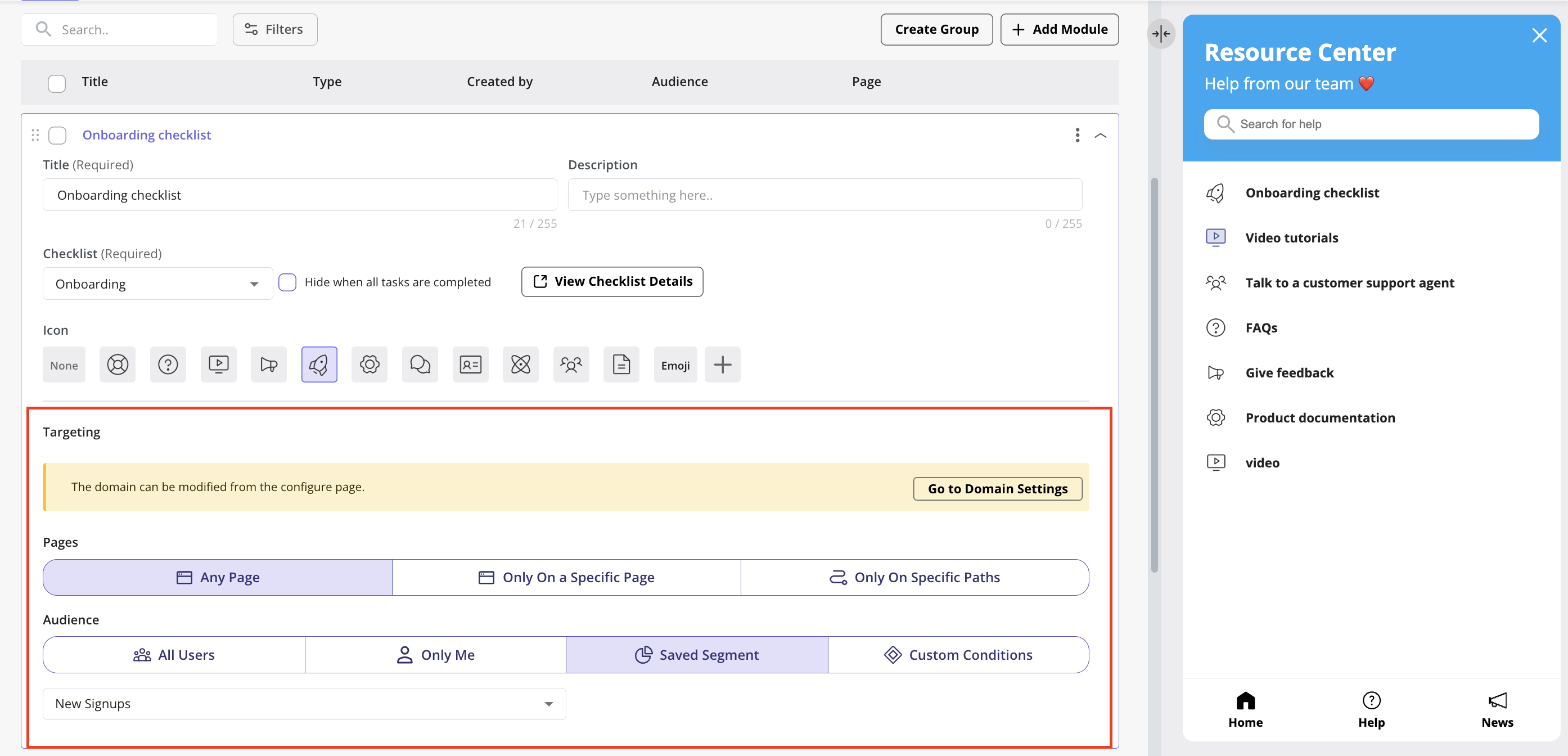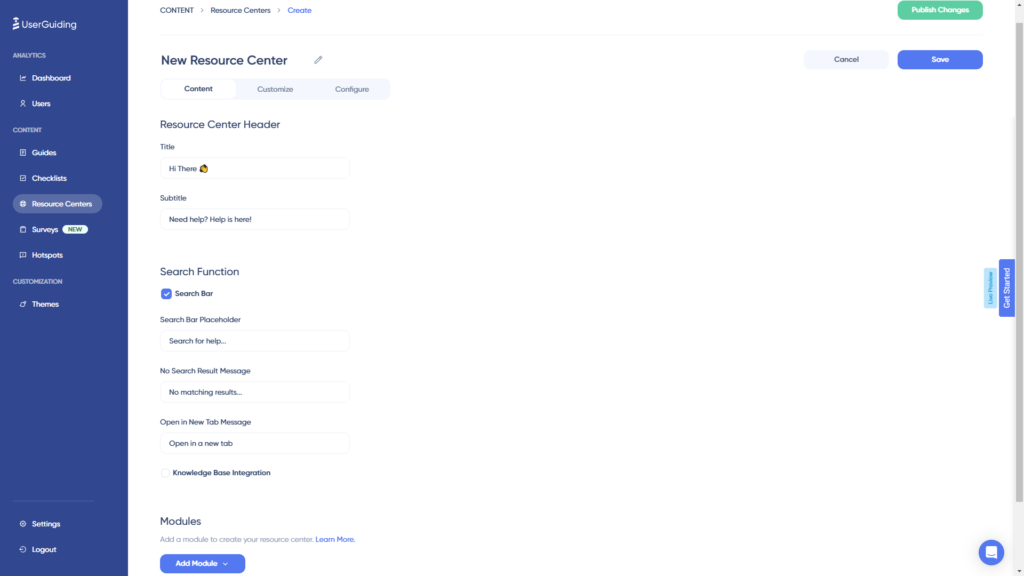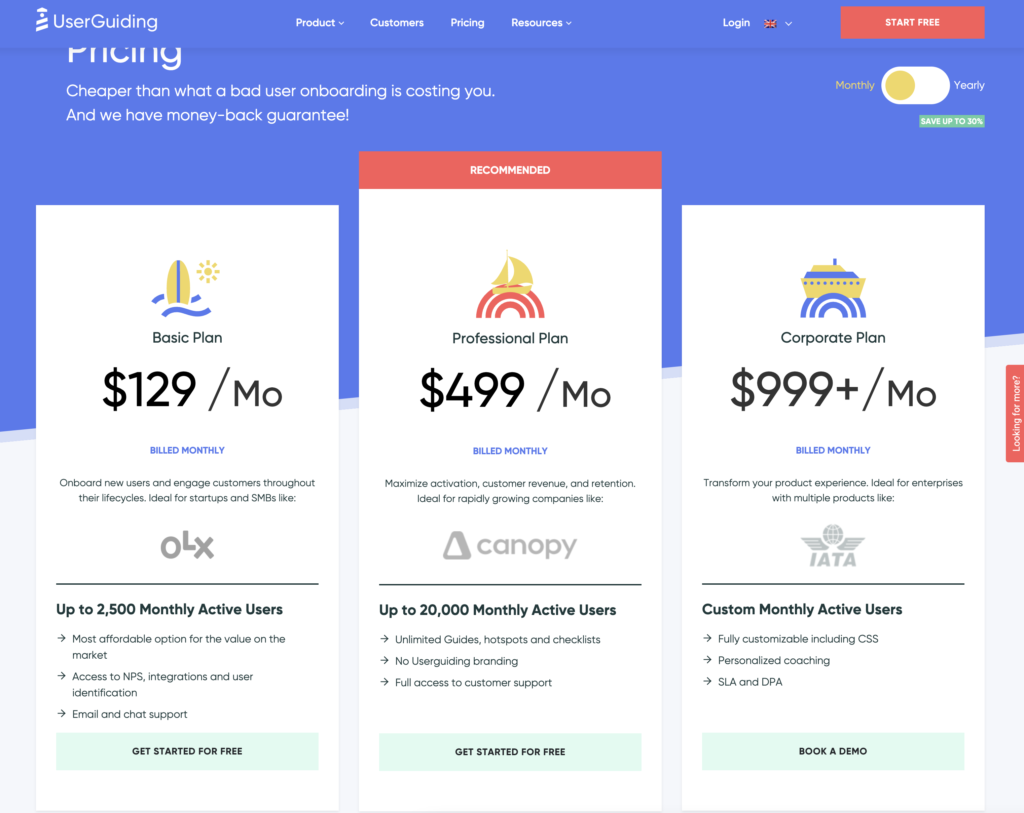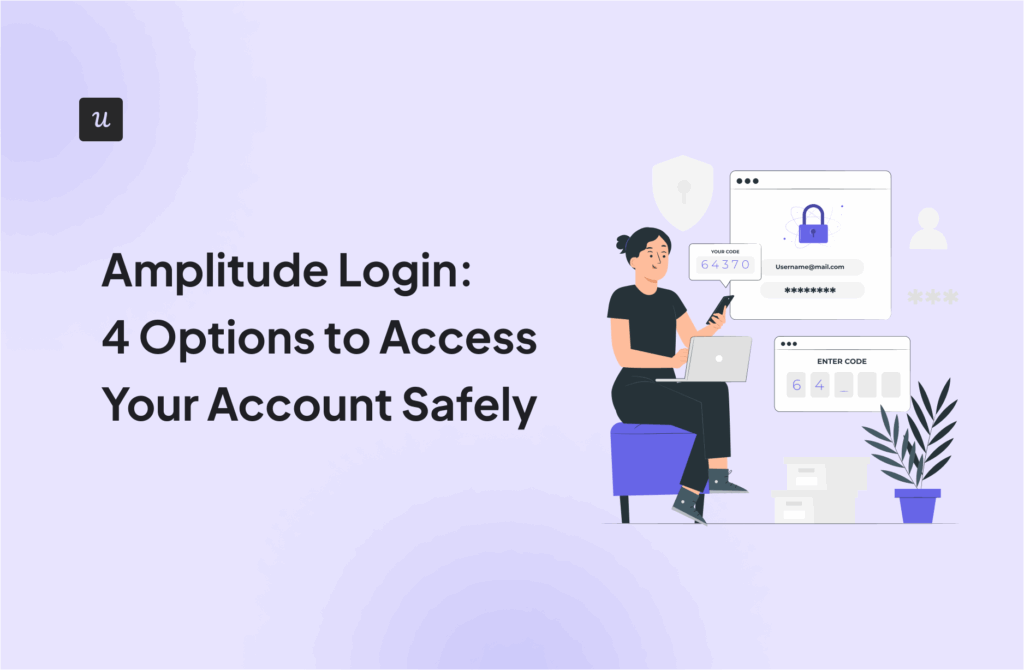
Try Userpilot Now
See Why 1,000+ Teams Choose Userpilot

What is WalkMe?
WalkMe is a digital adoption platform that can help you create frictionless experiences for your customers. The platform is built keeping the compliance, scalability, and security needs of enterprises in mind.
Using it, you can onboard customers and keep them engaged throughout their lifetime with your business. With powerful features like workflow automation and analytics, you can use it to grow your enterprise.
What are the main use cases for WalkMe?
Understanding the core functionalities and use cases of WalkMe is crucial for deciding whether or not it’s the right choice for you.
Without further ado, let’s see the primary scenarios where WalkMe is useful for your SaaS business!
WalkMe for user onboarding
Any digital adoption platform that seeks to gain the attention of businesses needs to have a solid lineup of features for user onboarding. It’s crucial because this is the stage where you can make a first impression on your users. Hand-holding them in this phase can help them get up to speed soon.
WalkMe has a bunch of features for user onboarding:
- You can create an onboarding checklist through the Onboarding Tasks feature on WalkMe. It’s possible to set different goals inside your checklist so users can keep checking them as they complete them. The Onboarding Tasks can include Smart Walk-Thrus, videos, and articles to guide your new users.
- You can also use WalkMe’s SmartTips feature to guide your users through the app’s UI. These serve as on-screen guidance and help reduce the learning curve for new users. Clicking on a SmartTip opens a pop-up that gives more information on the element.
- Likewise, you can use ShoutOuts to draw your new user’s attention to specific announcements. They’re essentially banners that you can use to show users what they need to know when getting started. You can also get them to take action through ShoutOuts.
- You could also use Launchers in your onboarding flow for some self-guidance. When users click on Launchers, a new action like a Smart Walk-Thru will get triggered. Users can click on each Launcher you create to learn more about your platform.
WalkMe for product analytics
Product analytics can help you uncover useful insights related to your product usage. It can play an important role in understanding how users engage with different elements on your pages and the features they use the most.
Getting insights into your product analytics can help you design a product that drives higher engagement.
WalkMe offers some advanced features for product analytics:
- The session playback feature can help you look into user sessions from the past year. By default, up to 1000 session playbacks will be visible in your account at any given time. You can use them to analyze past user sessions and even ones happening in real time.
- You also get user funnel tracking capabilities on WalkMe. It enables you to create a custom funnel to track various events. You can then monitor various metrics like funnel completion rates and drop-off rates to see how users interact with your platform. WalkMe also lets you filter the data based on browser, date ranges, and more.
- It’s also possible to get analytics on your in-app experiences to determine which features are being used the most by your users.
WalkMe for self-service support
Whether you’re looking to onboard new customers or employees, self-service support can go a long way to enhance the experience. It plays a key role in empowering users and minimizing the burden on your customer support team.
As a digital adoption platform, WalkMe offers several features to facilitate self-service support. From in-app messages and interactive guidance to a full-fledged resource center, there are various ways to help users navigate an application and troubleshoot problems on their own.
The features that come in handy here include:
- Smart Walk-Thrus – These include a series of tip balloons that help you provide interactive step-by-step guidance. They’re ideal for creating detailed product tours to handhold new users.
- SmartTips and ShoutOuts – Both these features help you engage users with strategic guidance. SmartTips are tooltips that let you highlight specific features and how to use them. On the other hand, ShoutOuts are in-app messages that help convey urgent announcements and updates. The best part is that you can add CTAs, video tutorials, and web page links to ShoutOuts.
- ActionBot – This is a chatbot feature that’s integral to self-service support. With ActionBot, you can automate the process of responding to user requests, answering FAQs, and nudging users to the right knowledge base resources.
- WalkMe Menu – It’s a handy widget that gives users access to all WalkMe experiences, irrespective of where they are in your product. That, in turn, ensures users can access relevant support resources without exiting the page. The drag-and-drop interface makes it easy to create your menu too.
Additionally, it’s worth noting that you can use WalkMe’s user segmentation features to provide contextual and personalized support to users at the right time.
What are the pros and cons of WalkMe?
Pros of WalkMe?
WalkMe is among the most popular platforms out there for digital adoption, especially for enterprises. It’s got a range of useful features that businesses can leverage to create in-app engagements, track user behavior, and retain customers, among other things. Here are the pros of using WalkMe:
- Multiple in-app engagements: Offers a bunch of in-app engagement options, including product tours, tooltips, help widgets, onboarding checklists, and more. Using them well can help you engage your customers.
- User-friendliness: The platform is quite user-friendly in terms of creating in-app engagements. And while it does have a moderate learning curve as a whole, it becomes easy to use once you get the hang of it.
- Lots of analytics: WalkMe provides in-depth analytics on a range of things like in-app engagements and forms to help you understand the impact that they’re creating. This helps you optimize your strategies for better results.
- Workflow automation: Workflow automation features like onboarding automation stand out as they enable you to automate a series of steps and processes like clicking buttons to make your customer experience better.
- Community: WalkMe offers a strong community of experts and partners who can help you whenever you get stuck.
Cons of WalkMe?
While WalkMe has a bunch of good things to offer that make it one of the leading digital adoption platforms out there, it does have a few drawbacks that prevent you from unlocking its full potential. Let’s take a look at some of the cons of this platform:
- Coding knowledge: Even though WalkMe is no-code/low-code for most of its functions, you’ll need to know HTML or CSS to make the most out of the platform.
- Challenging on complex sites: The process of implementing WalkMe on your website depends on the complexity of your site. You might find it challenging to ensure that your content behaves the way it should if you’ve got a complicated website.
- Focused on employees: WalkMe’s primary use case lies in digital adoption for employees, even though it has a specific plan for customers. However, this makes it slightly weaker compared to other platforms that have been dedicatedly built for customers.
What do users say about WalkMe?
WalkMe is a cutting-edge digital adoption platform built for both employees and customers and is used by numerous enterprises all over the globe. It’s got a rating of 4.5 (out of 5) on G2 with 349 reviews.
Customers particularly praise its automation and the ease of using the WalkMe builder. Here’s what a customer had to say:
“WalkMe – a perfect guidance that is closer than you think.”
From end-user perspective, WalkMe blends so well into the desired webpage, it’s hard to distinguish. By doing so, the user doesn’t have the feeling of interacting with ‘yet another pop up window’, with an incline to close it off as soon as it’s pop up. It provides a clear guidance at the moment of need, so whether you’re an experience user that just forgot how to do one things or a total newbie, it will provide a tailored solution to guide you to the end goal.
From WalkMe builder perspective, it’s simple to create a content and maintain it. Then you can analyse how it is performing, draw conclusions & improve the guidance. By doing so, you’re always on top of what users expect to see.” – Pawel Z., Feature Owner, Enterprise
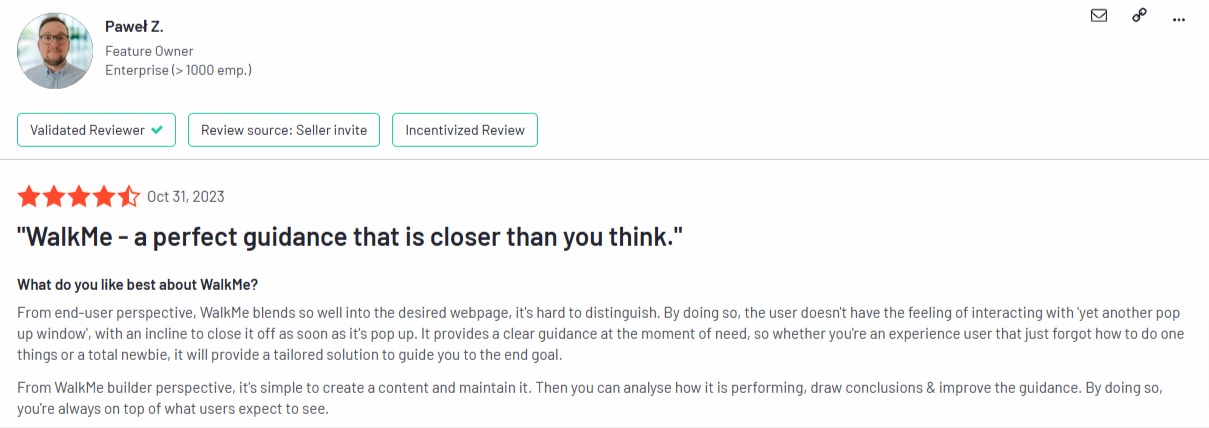
“Embedding Guidance/Scripting/Context Within Other Systems” It is a complicated tool that requires decent understanding of the system you are building it in, & how to use the rules engine/logic to trigger the content. We used WalkMe in 3rd party partner websites, however if you were to use it within your own platform, where you have full access to the HTML/programming it would likely be much easier to maintain/upkeep. – Taylor C., Training Manager, Mid-Market
Does WalkMe fit your budget?
WalkMe’s pricing isn’t transparent, but it’s fully customizable based on your requirements. It offers a bunch of useful features like analytics, a self-serve content creation engine, in-app engagement creation, and more.
However, you need to get in touch with their team to find pricing details for both the customer and employee versions. Considering the platform is specifically built for enterprises, you can expect the cost to be on the higher end. You could end up spending anywhere between $9000 to $50,000 per year if you choose to use WalkMe.
3 Reasons why you might need a WalkMe alternative
WalkMe ticks a lot of the right boxes if you’re looking for a digital adoption platform that’s intuitive and scalable. However, business requirements can vary and that could mean that WalkMe might not be the right fit for you. Here are three reasons why you may need to opt for a WalkMe alternative:
- You have a low budget: WalkMe is purpose-built for enterprises and it shows in its pricing. You can expect the cost to go into thousands of dollars annually. If your business doesn’t have a huge budget, it might be better to opt for another platform.
- You want to get started quickly: If you want a platform that offers near-plug-and-play functionality, you’re better off choosing another digital adoption platform as WalkMe has a moderate learning curve.
- You don’t want to work with CSS/HTML: Even though WalkMe is marketed as a no-code/low-code platform, there are some aspects where you’ll need CSS/HTML knowledge for customizations. If you want a fully no-code solution, you’re better off opting for an alternative.
Better alternatives to WalkMe
Considering alternative options to WalkMe can often lead to discovering more tailored solutions that better suit your needs. Here are the top WalkMe alternatives you can consider:
- Userpilot is a product growth platform that drives user activation, feature adoption, and expansion revenue. It also helps product teams collect user feedback, streamline onboarding, and gather actionable insights from analytics. With Userpilot, you’ll be able to track both product usage and user behavior to get a holistic view of how customers use your product — which will guide future development, improve the user experience, and inform your growth efforts.
- Spekit is a digital enablement tool that focuses on employee onboarding rather than user onboarding. The software is effective at educating new employees about which tools are in your tech stack and how to use each solution. Spekit also has an internal database system that lets users add, update, or search for information — called Speks. These Speks could consist of onboarding material, product documentation, best practices, SOPs, or other types of resources.
- Whatfix is a digital adoption platform that helps enterprise organizations with onboarding, training, and supporting their employees or customers. It accomplishes this through in-app guidance and messaging to provide on-demand support whenever it’s needed. The solution also lets you track analytics on all in-app guidance, collect user feedback, build out self-serve content, and automate certain flows. Whatfix even has integrations with Salesforce, Amplitude, Google Analytics, Slack, Confluence, and other platforms to maximize collaboration.
- UserGuiding is a no-code product adoption tool that lets users create in-app walkthroughs, guides, and checklists. The solution makes it possible for teams to onboard, engage, and retain users without needing coding skills to create these in-app experiences. All in all, UserGuiding is a pretty flexible solution that can improve the onboarding process, boost user engagement, and increase customer retention.
Let’s see the features and functionalities of these tools for different use cases!
WalkMe vs Userpilot
There are many ways how Userpilot is different (and in a lot of ways better!) from WalkMe. Let’s explore the features of Userpilot, how it’s better than WalkMe, and how it may fall short too.
Userpilot for user onboarding
User onboarding is a crucial part of the customer journey as it speeds up the adoption process and increases retention rates. Onboarding is one of Userpilot’s core use cases along with product growth analytics and user feedback, so it has plenty of features that you can utilize.
Here are some Userpilot features you can use when onboarding new users:
- No-code builder: Creating flows with Userpilot is as simple as installing the Chrome extension, selecting the UI patterns you’d like to use, and then editing the content/settings to suit your use case. You can also use templates to create modals, slideouts, tooltips, and driven actions.
No-code flow builder in Userpilot. - Native tooltips: Userpilot lets you create native tooltips that show up when users hover over an element or click on an information badge. Since these native tooltips attach to the element itself, they aren’t page-dependent and will show up on any screen where that element is visible.
Build native tooltips with Userpilot. - Advanced flow settings: With advanced condition settings, you can decide when, where, and who you’ll be triggering your onboarding flows. This helps you create contextual and personalized onboarding experiences that drive engagement and adoption.
- Onboarding engagement analytics: You can easily assess the impact of your onboarding flows, guidance, etc. by analyzing the engagement rate of tooltips, interactive walkthroughs, checklists, etc. In addition, you can also build reports (funnels, paths, etc.) or dashboards to track your core onboarding metrics i.e. activation, stickiness, drop-offs, etc.
Userpilot for product analytics
Product analytics lets you collect and analyze data about how users interact with your product so you can extract actionable insights. Userpilot lets you look at granular product analytics, such as which features have the highest adoption rates, and big-picture insights like trend reports. Here are Userpilot’s top product analytics features:
- Feature tagging: Userpilot’s click-to-track feature tagger lets you view how many times a feature has been used and by how many users to measure its adoption. Users on the Starter plan can add up to 10 feature tags while those on the Growth or Enterprise tier can create unlimited tags.
No-code feature tags in Userpilot. - Event-tracking: Alongside no-code feature tags for feature engagement tracking, you can also track other events unique to your product using event-tracking. You can also create a group of events to track a specific process i.e. onboarding, subscription, etc.
Create tracked events to monitor server-side data. - Trends and funnels: Userpilot’s trends and funnels report lets you extract actionable insights from big data. You’ll be able to see which stage of an onboarding/conversion funnel most users drop out on and create trend reports with detailed breakdowns by user or period.
Example of a trend report in Userpilot. - Retention tables: This lets you gauge product performance – how effective it is at retaining users using cohort tables and retention curves.
- Paths: You can generate and access path reports directly within the reporting builder in Userpilot, alongside funnels, trends, and retention reports. With Paths, you can have an overview of how users navigate your product features – offering invaluable insights into their interactions with your products.
- User & Company profiles: Here you can view data related to a certain user/company to gain insights into their behavior and improve the overall user tracking experience. This helps you understand how they engage with your product or platform, better identification of areas of improvement, and tailor their offerings more effectively.
User profile with top event data that provides insights into what feature they regularly engage with. - Analytics dashboards (Product Usage, New Users Activation, Core Feature Engagement, User Retention, etc.): These dashboards enable you to keep track of your key product performance and user behavior metrics at a glance, without any technical setup required.
- Analytics integrations: Userpilot integrates with some of the most popular analytics tools like Amplitude, Mixpanel, Segment, Google Analytics, and more. This makes it possible to sync product analytics both ways between the tools in your tech stack (two-way integration is only available for Hubspot at the time of writing, more to come).
Userpilot for self-service support
Here’s how you can use Userpilot to create a self-service customer experience:
- No-code builder: Userpilot’s no-code resource center lets you add modules without writing a single line of code. Module options include links, videos, flows, custom JavaScript functions, and checklists. You can also group modules into sections to help users navigate the resource center.
Add different types of content to your resource center. - Module segmentation: Userpilot’s segmentation settings let you hide or show specific modules within your resource center based on audience settings. This makes it possible to create modules for different user segments and hide resources that aren’t relevant to other users.
Help module visibility condition settings. - Resource center analytics dashboard: The dedicated analytics dashboard helps you see how many unique visitors your resource center gets, how many modules have been clicked, the overall click rate across your user base, and popular search terms. This will make it easier to gauge resource center performance and identify if anything is missing from your resource center.
Resource center content analytics in Userpilot.
Pricing of Userpilot
Userpilot offers flexible pricing based on your monthly active users (MAUs). Plans start at $299 per month for smaller teams and scale as your user base grows.
Below are the pricing tiers you can choose from:
- The Starter plan begins at $299/month (billed annually) for up to 2,000 monthly active users. It includes in-app user engagement, usage trend analysis, NPS surveys, and essential product analytics—ideal for mid-market SaaS teams getting started.
- The Growth plan offers custom pricing and adds advanced analytics, retroactive event auto-capture, in-app surveys, session replay, and more. It’s the most popular choice for growing teams that need deeper insights and scale.
- The Enterprise plan offers custom pricing and includes everything in Growth, plus bulk data handling, custom roles and permissions, SOC 2 Type 2 compliance, and enterprise-level support.
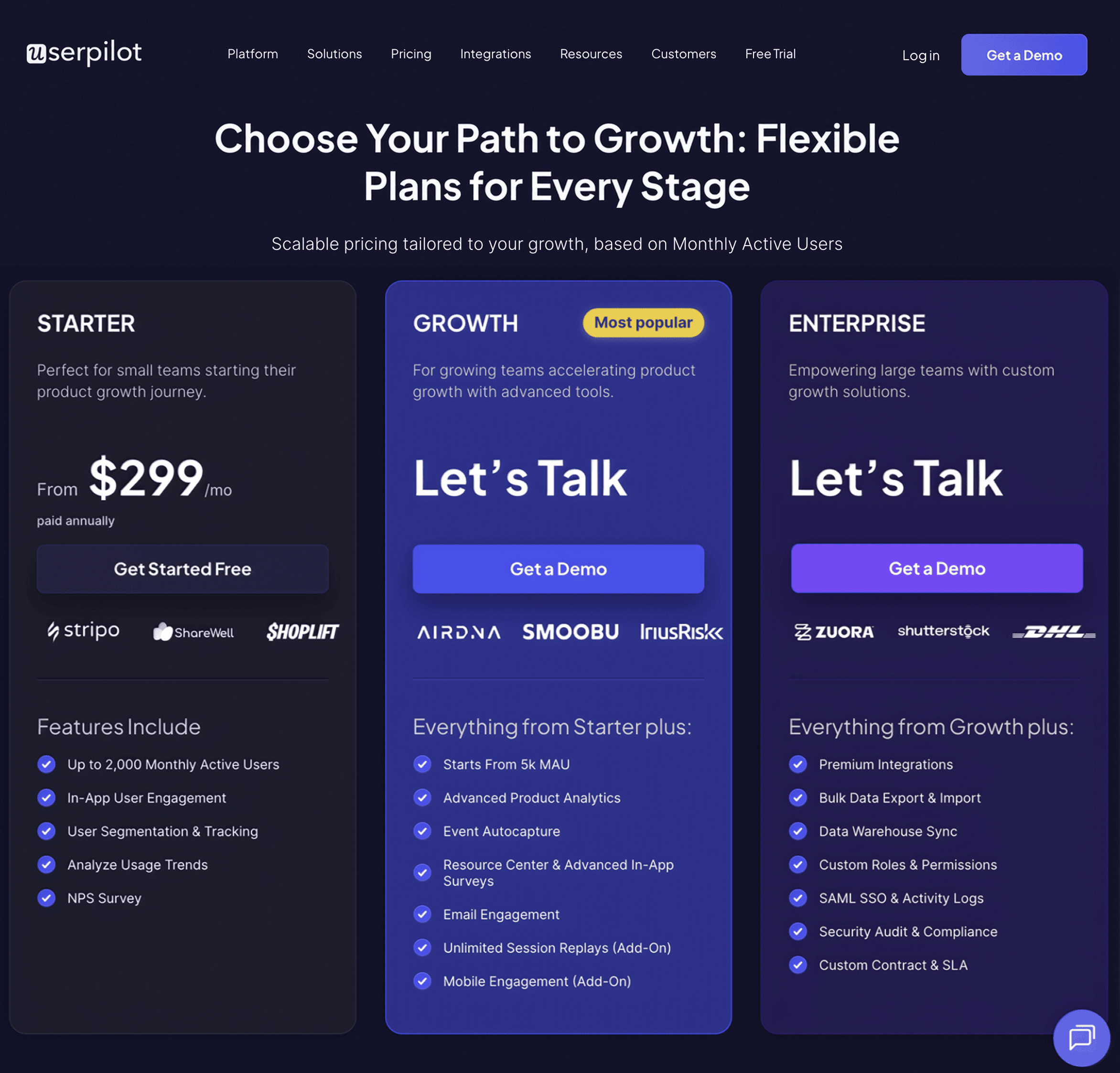
WalkMe vs Spekit
There are many ways how Spekit is different (and in a lot of ways better!) from WalkMe. Let’s explore the features of Spekit, how it’s better than WalkMe, and how it may fall short too.
Spekit for user onboarding
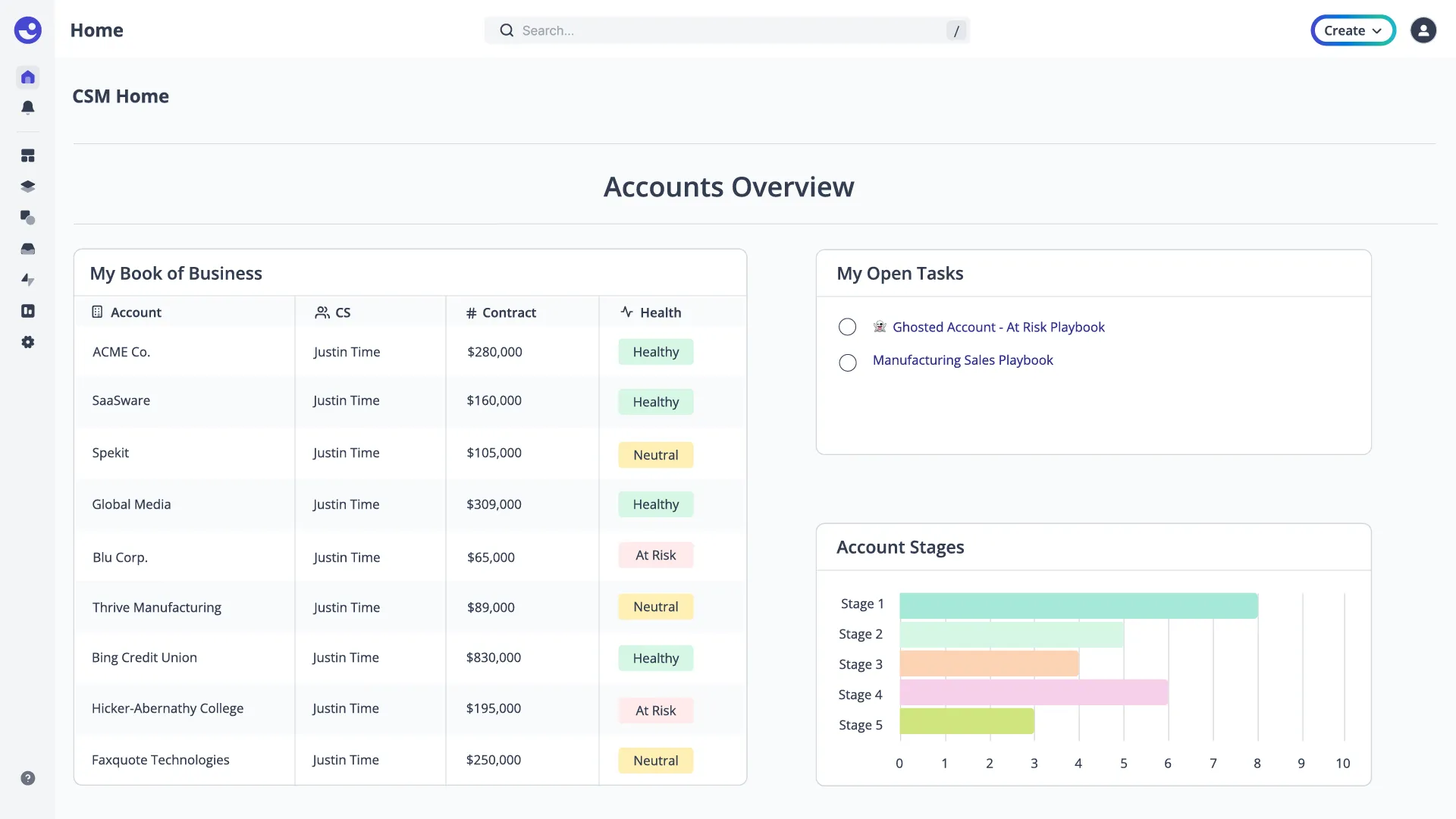
Spekit isn’t a user onboarding tool as it’s only built for employee onboarding. This means it can help your new users navigate third-party tools and workflows through its no-code walkthroughs. Here’s an overview of how Spekit can help with employee onboarding:
- Codeless Walkthroughs: Spekit lets you build step-by-step walkthroughs for new employees without needing to write any code. Unfortunately, the UI patterns available for walkthroughs are limited to tooltips and modals.
- Flow Versioning: Spekit lets you record and edit walkthroughs or save them as drafts to finish later. You’ll also be able to preview the placement of each step, edit text, and delete superfluous steps at any point then update your changes.
- Multi-Tool Flows: You can create a single flow that guides your new employees across two or more tools. This is because Spekit is installed at the browser level rather than on the actual third-party tool so you’re free to switch between various software platforms during flows.
Spekit for product analytics
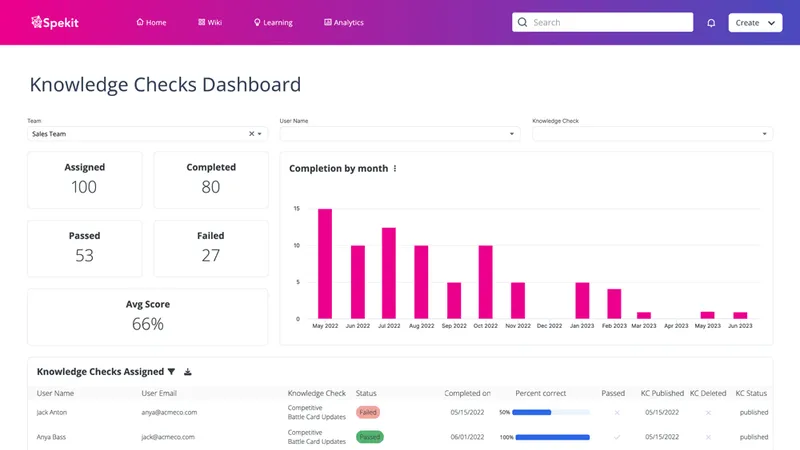
Spekit is installed as a Chrome extension rather than code that’s inserted into the third-party application. This means that it has no means of reporting on (or even accessing) product analytics data. The only metrics center around engagement with your training materials.
Spekit for self-service support
Spekit cannot be used to build a self-service support infrastructure as the solution is not installed on any software itself (instead functioning as a UI layer only visible to employees on your team). However, Spekit can still be utilized as a self-service support tool for internal use.
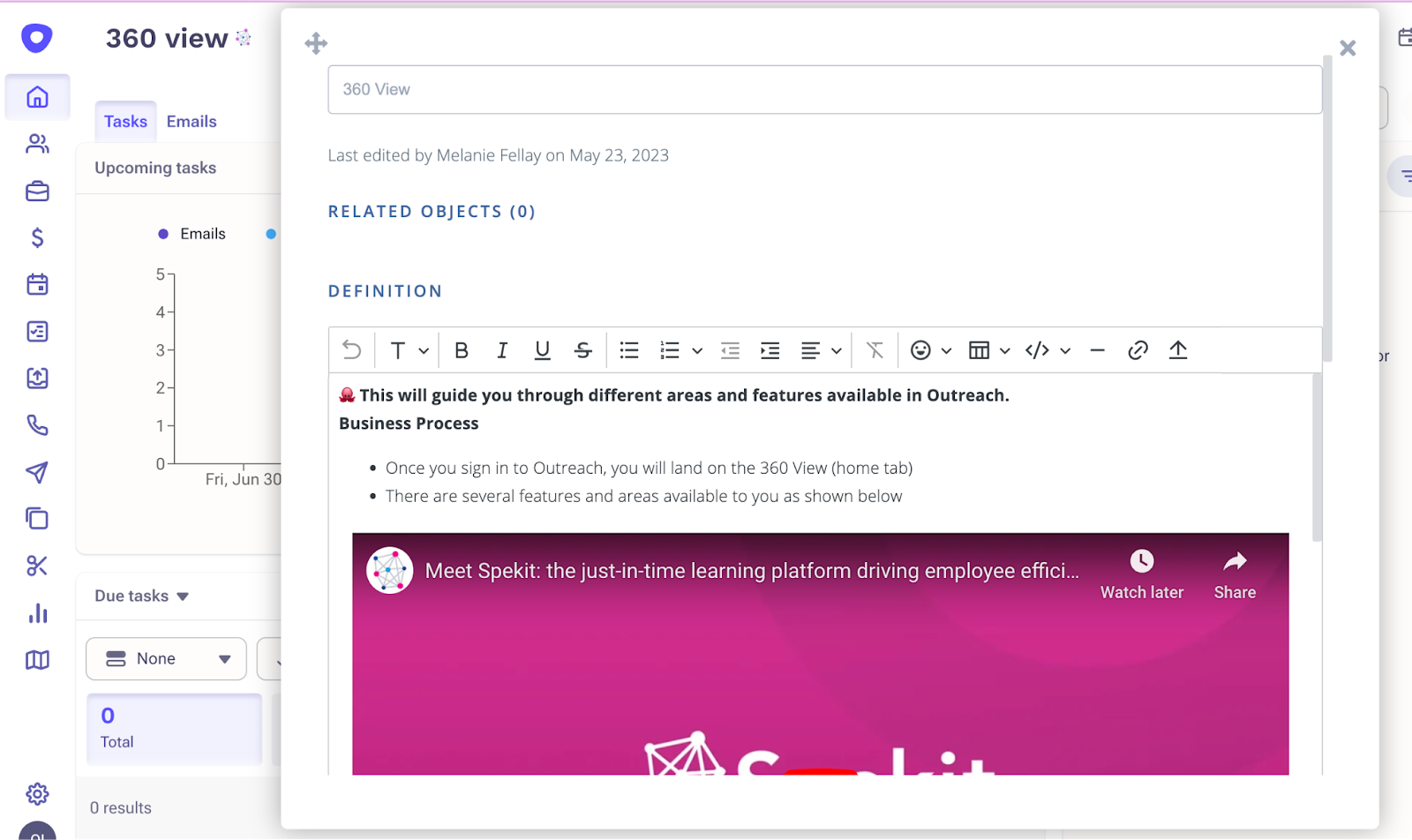
Any resources created with Spekit — known as Speks — can be accessed by clicking on the Chrome extension and using the search bar. This makes the company wiki accessible on any page and provides easy access to every Spek created through the Spekit web app or Chrome extension.
Pricing of Spekit
While Spekit previously charged $20/month for each user, they have since updated their pricing model. The price will now vary based on the size of your organization and which use cases you’ll be deploying the product for.
Spekit doesn’t have a freemium plan nor does it offer a free trial.
This means that you’ll need to contact the Spekit sales team and pay for a proof-of-concept to get an idea of how the solution works. Features like seismic integration, knowledge checks, and knowledge check analytics are sold as add-ons that cost extra on top of your base subscription.
WalkMe vs Whatfix
There are many ways how Whatfix is different (and in a lot of ways better!) from WalkMe. Let’s explore the features of Whatfix, how it’s better than WalkMe, and how it may fall short too.
Whatfix for user onboarding
User onboarding is a complex process that only the most flexible tools can pull off. Whatfix has its fair share of bugs and technical quirks but there are a few features that bolster its onboarding capabilities — namely its tours, checklists, and integrations.
Here’s an overview of Whatfix’s onboarding features:
- Whatfix lets you create interactive product tours for both users and employees. This reduces the time to value (TTV), whether it’s for customers using your product or employees learning how to use a solution in the internal tool stack.
- Onboarding checklists (known as task lists on Whatfix) give new users or employees a clear next step on their journey toward product adoption. Whatfix lets you create these checklists as widgets target specific segments, and group tasks under headers.
- Whatfix’s gallery of direct integrations with tools like Salesforce, Amplitude, SurveyMonkey, and more helps you centralize all onboarding data. The onboarding metrics gathered and synced across tools can then help you streamline your in-app flows.
Whatfix for product analytics
Whatfix has a separate product analytics solution that is billed separately from its mainline digital adoption platform (but has no pricing listed on the website).
Here’s an overview of Whatfix’s product analytics capabilities:
- Whatfix has both trend and funnel report types available which can help you see how your customers or employees use different software applications. This will show you which paths users take, which elements they interact with, and what browser/OS they use to do so.
- Track user properties like the type of device they’re on, which browser they’re using, or where they’re from. Unfortunately, this data isn’t available for desktop-based applications.
- Limitations: Whatfix analytics lacks clarity and scalability (especially on the entry-level plan). Those on the Standard plan can only tag 25 actions and there’s no indication of how much it will cost to lift that limit by upgrading.
Whatfix for self-service support
Providing self-service options for employees and customers is crucial for multiple reasons. Mainly, it speeds up the product adoption process while simultaneously reducing the workload for your support team. Whatfix lets you offer multiple types of self-service support.
Here’s an overview of Whatfix’s self-service support functionality:
- In-App Guidance: Whatfix’s in-app guidance features can be used to show customers or employees how to use a particular application. These flows could go over specific processes, highlight individual features, or serve as a walkthrough for the overall onboarding sequence.
- Contextual Help: You can use Whatfix to provide contextual support to users when they need it most, so they don’t need to take up your team’s time by submitting tickets. These self-help resources make the answer to common queries easily accessible from anywhere on the web.
- Multi-Channel Support: Whatfix gives you the ability to provide technical support throughout every touchpoint your organization uses. This includes email, chat, social media, support platforms, or other channels that the company utilizes to assist users.
Pricing of Whatfix
Whatfix doesn’t have public pricing listed on its website. It also charges separately for its product analytics solution but we won’t be going over those plans since we’re focusing on the digital adoption platform.
Here’s an overview of the three plans available for Whatfix web:
- Standard: This includes core features like in-app guidance, contextual guidance, a multi-media knowledge base, and content aggregation capabilities. It also includes access to pre-built surveys and up to two integrations.
- Premium: This includes additional features such as automatic content localization, automated flow testing, unlimited integrations, and single sign-on (SSO). You’ll also be able to build custom surveys while on the Premium plan.
- Pro: This includes the features from previous plans as well as enterprise-exclusive options such as self-hosting. This plan is targeted towards customer-facing applications with a million or more users.
WalkMe vs UserGuiding
There are many ways how UserGuiding is different (and in a lot of ways better!) from WalkMe. Let’s explore the features of UserGuiding, how it’s better than WalkMe, and how it may fall short too.
UserGuiding for user onboarding
As a no-code onboarding tool, UserGuiding has numerous features that will help you create onboarding flows for your new customers and guide them throughout their journey.
Here’s what you’ll get when you start using UserGuiding:
- Create interactive product walkthroughs without disturbing your developers as it’s completely code-free.
- Build onboarding checklists and drive customers to the activation point by eliminating the guesswork on what the next step should be.
- Create interactive elements, such as product tours, tooltips, and pop-ups, to help keep users engaged and increase the likelihood that they’ll complete the onboarding process.
- Create a resource center to add different educational resources for your users.
Though UserGuiding is a great tool for startups that don’t have much money to invest in an onboarding tool, it has very strict limitations for the Basic plan.
You can only create a maximum of 20 guides and hotspots, 2 onboarding checklists, and 1 resource center. If you want to create unlimited guides with unlimited UI patterns, you should go for the Professional plan which can cost from $299 to $399.
The one drawback when using UserGuiding for onboarding is the fact that its analytics dashboard only encompasses the elements that you’ve created within the platform. In contrast, Userpilot is able to track all elements, events, and behaviors throughout the entire user journey.
UserGuiding for product analytics
Product analytics are a cornerstone of any growth strategy as they offer insights into how existing customers have used the product. They can also highlight similarities between users within certain cohorts (such as power users or churned customers).
Unfortunately, UserGuiding has no native product analytics capabilities. The only data it’s able to collect are interactions with UserGuiding materials such as guides, checklists, hotspots, or resource centers.
It does have integrations with analytics platforms like Amplitude, Mixpanel, Segment, and Woopra. However, the depth and flexibility vary from integration to integration — not to mention the fact that you’ll need to pay extra for a standalone analytics product before you can integrate it.
UserGuiding for self-service support
As an onboarding solution, UserGuiding is targeted toward the initial tours, walkthroughs and flows that new users go through. However, it does have certain customer education features that could be utilized in the context of self-service support:
- Resource Center: The most suitable UserGuiding feature for self-service support is the resource center. Resource centers created with UserGuiding are also equipped with a search function to help users find the resources that they need.
- Localization: Self-service support can be tricky if your product has a multilingual user base, but UserGuiding does have localization features that can help with that. It’s worth noting that the localization is NOT automated, so you’ll need to manually download, translate, and upload CSVs.
- Analytics: UserGuiding’s analytics dashboard shows you how many interactions your resource center has had in the past seven days, which can be useful when trying to measure engagement with self-service resources.
Pricing of UserGuiding
UserGuiding has three plans to choose from, targeted towards a range of business sizes from startup to enterprise.
Here are UserGuiding’s specific pricing details:
- Basic: Costing $129/month, the Basic plan is targeted towards startups and SMBs. The Basic plan is quite limited as it caps your account at one active survey, two active checklists, and no more than 2,500 MAUs. Features include:
- Access to user identification features.
- Integrations with Google Analytics, HubSpot, Intercom, and more.
- Email and chat support.
- Customizable theme (only one).
- Professional: The Professional plan costs almost 4x as much as the Basic tier at $499/month. That said, it significantly increases capacity to 20,000 MAUs and improves the quality of customer support you’ll receive. Features include:
- Removal of UserGuiding branding.
- Language localization.
- Full customer support access.
- Five team member seats.
- Five customizable themes.
- Unlimited guides and checklists.
- Corporate: Subscriptions on the Corporate plan start at $999/month. Of course, this higher price does come with its fair share of enterprise perks. Features include:
- Service Level Agreement (SLA) + Data Processing Agreement (DPA).
- Up to 10 active surveys.
- Custom MAU capacity based on your needs.
- Unlimited team member seats.
- Unlimited customizable themes.
All monthly plans are marked down by 30% when customers choose to bill annually.
Conclusion
As you can see, there are many different competitors and alternatives to WalkMe. We’ve discussed a few above – but which one is the best?
The answer is “it depends” – but we strongly believe that if you’re a mid-market SaaS company looking for a great user onboarding and product analytics tool, Userpilot is the best option for you.
Hopefully, you found this post helpful. And if you need any help with how Userpilot is different, schedule a demo to get started!


